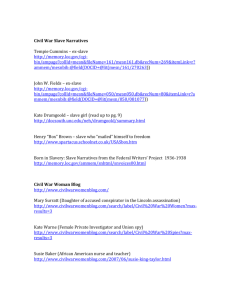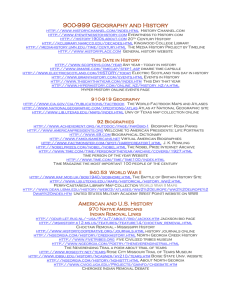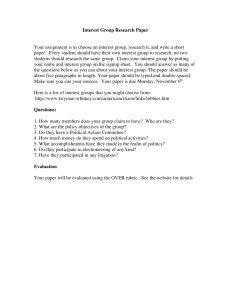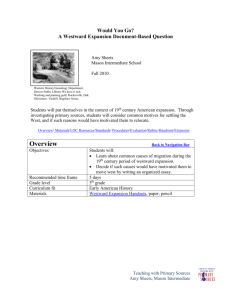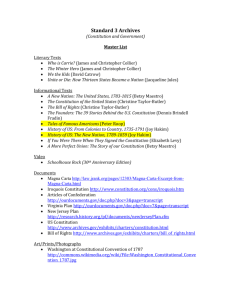Replace This Text With The Title Of Your Learning Experience
advertisement
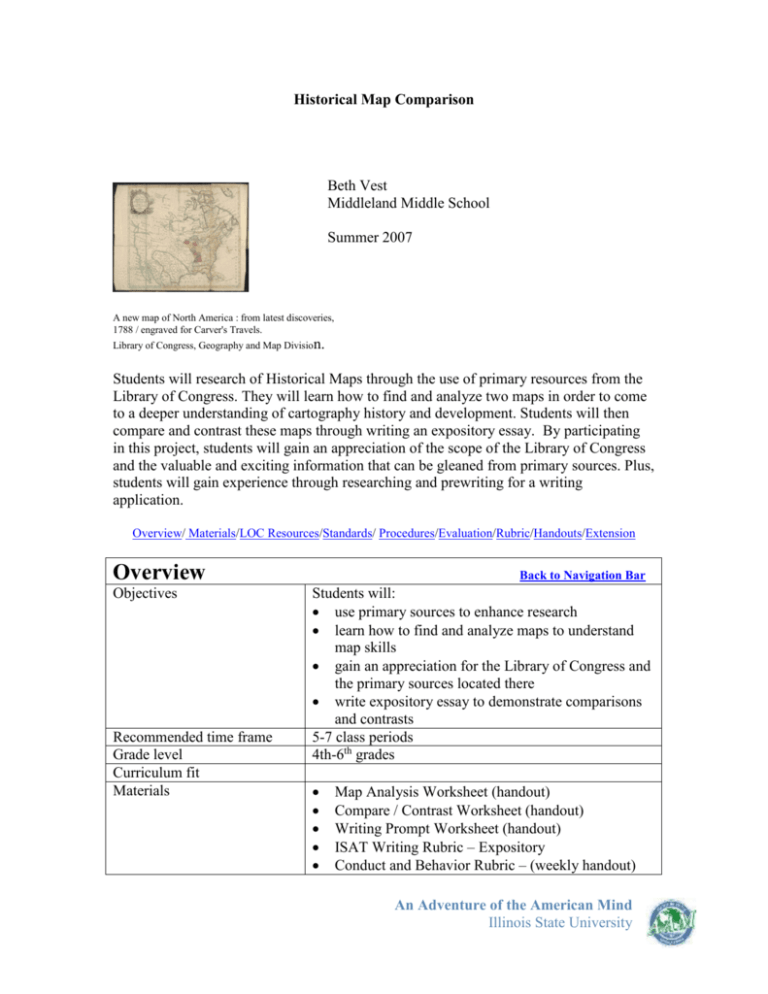
Historical Map Comparison Beth Vest Middleland Middle School Summer 2007 A new map of North America : from latest discoveries, 1788 / engraved for Carver's Travels. Library of Congress, Geography and Map Division. Students will research of Historical Maps through the use of primary resources from the Library of Congress. They will learn how to find and analyze two maps in order to come to a deeper understanding of cartography history and development. Students will then compare and contrast these maps through writing an expository essay. By participating in this project, students will gain an appreciation of the scope of the Library of Congress and the valuable and exciting information that can be gleaned from primary sources. Plus, students will gain experience through researching and prewriting for a writing application. Overview/ Materials/LOC Resources/Standards/ Procedures/Evaluation/Rubric/Handouts/Extension Overview Objectives Recommended time frame Grade level Curriculum fit Materials Back to Navigation Bar Students will: use primary sources to enhance research learn how to find and analyze maps to understand map skills gain an appreciation for the Library of Congress and the primary sources located there write expository essay to demonstrate comparisons and contrasts 5-7 class periods 4th-6th grades Map Analysis Worksheet (handout) Compare / Contrast Worksheet (handout) Writing Prompt Worksheet (handout) ISAT Writing Rubric – Expository Conduct and Behavior Rubric – (weekly handout) An Adventure of the American Mind Illinois State University Illinois State Learning Standards Back to Navigation Bar Language Arts: GOAL 3: Write to communicate for a variety of purposes. 3.A. Use correct grammar, spelling, punctuation, capitalization and structure. 3.B.2a Generate and organize ideas using a variety of planning strategies (e.g., mapping, outlining, drafting). 3.B.2b Establish central idea, organization, elaboration and unity in relation to purpose and audience. 3.C.2b Produce and format compositions for specified audiences using available technology. Social Studies GOAL 16: Understand events, trends, individuals and movements shaping the history of Illinois, the United States and other nations. 16.A. Apply the skills of historical analysis and interpretation. 16.A.2c Ask questions and seek answers by collecting and analyzing data from historic documents, images and other literary and nonliterary sources. 17.A Locate, describe and explain places, regions and features on the Earth. 17.A.2b Use maps and other geographic representations and instruments to gather information about people, places and environments. Procedures Back to Navigation Bar Day One: On the Smart Board, Introduce the Library of Congress Website http://www.loc.gov/ Using Map 30 of 111 http://memory.loc.gov/cgibin/query/r?ammem/gmd:@filreq(@field(NUMBE R+@band(g3300+ct001320))+@field(COLLID+dsx pmap)) as an example, we will zoom in to analyze and discuss. The first stop on our comparison project will be the following maps: An Adventure of the American Mind Illinois State University http://memory.loc.gov/cgibin/query/r?ammem/gmd:@filreq(@field(NUMBE R+@band(g3300+ct000705))+@field(COLLID+dsx pmap)) And http://memory.loc.gov/cgibin/query/r?ammem/gmd:@filreq(@field(NUMBE R+@band(g3300+ct001320))+@field(COLLID+dsx pmap)) On the Smart Board the class will work through a Map Evaluation Worksheet (handout) with the class leaving a copy of the Worksheet available for later observations and references. Teacher demonstrates how to cite the maps to place in a bibliography. Refer to the web site http://library.duke.edu/research/citing/within/mla.ht ml for directions of in-paragraph citing. Students will spend time in the computer lab navigating through the American Memory section of the Library of Congress website, browsing through the collections containing Maps and Cartographic Items ~ 1500-Present. In the computer lab students will independently find and choose two maps to compare and contrast. Students need to print their maps for visual reference. They will also need to cite the maps. Students will independently complete a Map Evaluation Worksheet (handout) for each map. Day Two: On the Smart Board revisit the web-sites http://memory.loc.gov/cgibin/query/r?ammem/gmd:@filreq(@field(NUMBE R+@band(g3300+ct000705))+@field(COLLID+dsx pmap)) And http://memory.loc.gov/cgibin/query/r?ammem/gmd:@filreq(@field(NUMBE R+@band(g3300+ct001320))+@field(COLLID+dsx pmap)) to re-examine the two maps and their Map Evaluation Worksheets. On the Smart Board the class will go through the Compare / Contrast Graphic Organizer (handout) using the Map Evaluation Worksheets from the previous lesson. An Adventure of the American Mind Illinois State University Students will work independently to complete the Compare / Contrast Worksheet (handout) to make their comparisons of their two maps. Day Three: On the Smart Board the class will complete the Writing Prompt Worksheet (handout) using the Compare / Contrast Worksheet (handout) from the day before. In the Computer Lab students will work independently to complete the Writing Prompt Worksheet (handout) Day Four: In the Computer Lab, students will work independently to write a Rough Draft using their Writing Prompt Worksheets (handout) from the day before. Day Five and Six (as needed): In the Computer Lab, students will independently use Dictionaries and Thesauruses to edit and proofread their Rough Draft. Day Seven: In the Computer Lab, students will work independently to finalize and print their essays. Evaluation Back to Navigation Bar Weekly Conduct and Behavior Rubric Use the ISAT Writing Rubric to assess the final written essay. Extension Back to Navigation Bar Visit the website on the Smart Board to Mapping Initial Encounters which discusses how Columbus’s arrival to the Americas affects Europeans, Native Americans, and Africans that continued for nearly 300 years. This video examines how these contacts began the phenomenon now known as the Columbian Exchange, profoundly altering the way of life of peoples around the globe. The video is about 28 minutes long. http://www.learner.org/resources/series208.html An Adventure of the American Mind Illinois State University Primary Resources from the Library of Congress Back to Navigation Bar Image Description American Memory Places in the News Map Collections Discovery and Exploration Cartographic Items: Americae sive qvartae orbis partis nova et exactissima descriptio / avtore Diego Gvtiero Philippi Regis Hisp. etc. Cosmographo ; Hiero. Cock excvde 1562 ; Hieronymus Cock excude cum gratia et priuilegio 1562. A new map of North America : from latest discoveries, 1788 / engraved for Carver's Travels. Carver, Jonathan, 1710-1780. Travels through the interior parts of North America. The 1562 Map of America by Diego Gutiérrez Citation Library of Congress, Geography and Map Division. Permanent URL http://memory.loc.gov/cgibin/query/S?ammem/gmd:@filreq (@field(COLLID+dsxpmap)+@fi eld(COLLID+ct)) Library of Congress, Geography and Map Division. http://memory.loc.gov/cgibin/query/r?ammem/gmd:@filreq (@field(NUMBER+@band(g329 0+ct000342))+@field(COLLID+d sxpmap)) Library of Congress, Geography and Map Division. http://memory.loc.gov/cgibin/query/r?ammem/gmd:@filreq (@field(NUMBER+@band(g330 0+ct001320))+@field(COLLID+d sxpmap)) Library of Congress, Geography and Map Division. http://memory.loc.gov/ammem/g mdhtml/gutierrz.html Shows the coast from the vicinity of the Cape Fear River in North Carolina of the United States, location of Indian settlements, and Library of Congress, Geography and Map Division. http://memory.loc.gov/cgibin/query/r?ammem/gmd:@filreq (@field(NUMBER+@band(g386 0+ct001033))+@field(COLLID+d sxpmap)) An Adventure of the American Mind Illinois State University lakes and rivers in the region to the Pánuco River in Mexico; the interior is as far north as the latitude of the Tennessee River. Santa Cruz, Alonso de, 1505-1567. Descripsion des costs, pts., rades, illes de la Nouuele France faict selon son vray méridien : avec la déclinaison de la ment de plussieurs endrois selon que le sieur de Castes le franc le démontre en son liure de la mécométrie de l'emnt. / faict et observé par le sr. de Champlain 1607. Shows coast of North America from western Nova Scotia to Cape Cod. Amérique septentrionale / par N. Sanson d'Abbeville, géog. du Roy ; avec priuilège [i.e. privilège] du Roy pour vingt ans ; A. Peyrounin sculp[teur]. Library of Congress, Geography and Map Division. http://memory.loc.gov/cgibin/query/r?ammem/gmd:@filreq (@field(NUMBER+@band(g332 1p+ct001431))+@field(COLLID+ dsxpmap)) Library of Congress, Geography and Map Division. Paris : Chez l'Auteur et chez Pierre Mariette, 1650. http://memory.loc.gov/cgibin/query/r?ammem/gmd:@filreq (@field(NUMBER+@band(g330 0+ct000705))+@field(COLLID+d sxpmap)) Sanson, Nicolas, 1600-1667. An Adventure of the American Mind Illinois State University Illinois State Aptitude Test Duke University Libraries Annenberg Media Learner.org Writing Rubric Fifth Grade Persuasive and Expository Essay Rubric MLA in-text parenthetical citations 1. View Programs 2. America's History in the Making ISAT StudentFriendly Rubric • Late Elementary— Narrative http://www.d124.org/gifted456/Pr oduct_matrix/Fifth_grade_persu_ expo_essay_rubric.htm MLA in-text parenthetical citations Teacher Resources by Annenberg Media http://library.duke.edu/research/cit ing/within/mla.html http://www.learner.org/resources/ series208.html 3. View Programs 4. Mapping Initial Encounters 5. View Video An Adventure of the American Mind Illinois State University Rubric Back to Navigation Bar Fifth Grade Persuasive and Expository Essay Rubric 6 5 4 Focus Elaboration Organization Integration • I have a great introduction that explains my topic. • I kept my focus. • The paper is logical. • I have a great closing, although it may be a restatement of points from the introduction. • All my ideas have specific supporting details. • I developed my paper with many examples, reasons, or explanations. • I used interesting and clear words to support my topic. • I ordered my ideas logically. • I used paragraphs appropriately. • My paper is connected between the paragraphs and flows within the paragraphs. • I used a variety of sentences. • I used a variety of appropriate transitions • I have a fully developed paper for my grade level. • I have a clear and developed focus. • I have balanced, specific details. • My sentences and paragraphs fit smoothly together • I introduced my topic • Most of my ideas have specific supporting details. • I develop my paper with some examples, reasons, or explanations. • I used interesting and clear words that support my topic. • I put my ideas in logical order. • Most of my paragraphs are correct. • Most of my paper is connected between the paragraphs and flows within the paragraphs. • Some of my sentences are varied. • I used appropriate transitions. • My paper is developed for my grade level. • I have developed all writing features, but some parts of my paper are better developed than others. • Some of my ideas have specific supporting details. • I developed my paper with some general examples, reasons, or explanations. • I put my ideas in logical order. • Many of my paragraphs are correct. • Some of my paper is connected between the paragraphs and flows within the paragraphs. • Some ideas do not fit my paper. • My paper is developed for my grade level. • My paper is simple, clear, and presents the essentials. .• I keep my focus. • The paper is logical. • I have a closing. • I may begin my writing without a clear introduction. • If I introduced the paper with a preview, I wrote only about my previewed points. • I gave some support to An Adventure of the American Mind Illinois State University • I used some simple transitions. maintain the subject. • Some of my paper is focused and logical. • I may have a closing. 3 • I may begin my paper with no introduction. • My subject or position may depend on my readers’ knowing the prompt. • I may not have stayed on topic with my subject or position. • I may have more than one position without tying them together. • I may not have written enough. • Few of my ideas have specific supporting details. • My details may look like a list. • I may not have written enough to support my topic. • I tried to explain my topic, but it was unclear. • Few of my ideas were in paragraphs, and they may not have been in order. • Many ideas do not fit my paper. • I may not have written enough. • I have inappropriate transitions. • My paper is partially developed for my grade level. • I have included all writing features, but at least one of these features is not complete. • I may not have written enough. 2 • My subject is unclear. • I wrote about different subjects, or I changed my focus. • I may not have written enough. • I may not have written a persuasive or expository paper. • I may have used unclear or unrelated supporting details. • My details may be a list of ideas that do not go together. • I have not written enough to show support. • I tried to explain my subject, but it did not make sense. • My paper has few correct paragraphs. • My paper has few transitions that make sense. • I may not have written enough. • My paper is not developed for my grade level. • I tried to use the features of writing in my paper but my readers may be confused. • My paper is not persuasive or expository. • I may not have written enough. 1 • My writing is confusing. • I did not write about the topic. • I did not write enough to • My writing is confusing. support my topic. • I did not write enough. • My writing is confusing. • I did not write enough. An Adventure of the American Mind Illinois State University • I have not written enough. C Conventions 2 • I have mastered sentence construction. • My paper may have a few invented spellings of uncommon words. • Subjects and their verbs agree correctly. • My paper has demonstrated mastery of basic punctuation and capitalization. 1 • The number of errors in my paper interferes with my readers’ understanding. Return to Core Products Page An Adventure of the American Mind Illinois State University Handouts Back to Navigation Bar Weekly Report Card for Participation and Behavior Weekly Conduct Grade Name ___________________ Date ___________________ Followed Routines and Procedures +2 Followed Verbal Directions +2 Followed Written Directions +2 Participates (raises hand to comment or ask questions) +2 No Disruptive Behavior +2 Lack of Participation and/or Effort (not disruptive) -1 Did Not Follow Routines and Procedures -2 Did Not Follow Verbal Directions -2 Did Not Follow Written Directions -2 Disruptive Behavior -2 __________ __________ __________ Total (possible score of 10) _________ __________ __________ __________ __________ __________ __________ __________ 10 (or more) demerits have been assigned for the above infractions. YES NO Parent Signature ____________________________ Date _________ Student Signature ___________________________ Date _________ Teacher Signature ___________________________ Date _________ Please return to teacher as soon as possible to ensure that we can elicit the best learning environment possible for your child. Since our school has each student’s grades on-line through a secure web-site, I would send this report card home with each student the first week to be signed by the parent and student. Then I would just enter a weekly conduct grade on-line. If a parent wanted to have a paper copy of this, then I would send it home with the student. If I needed to mail this document home, I would ask the office to prepare this for me. An Adventure of the American Mind Illinois State University Handouts Back to Navigation Bar Map Analysis Worksheet 1. TYPE OF MAP (Circle one): Bird's-eye map Raised Relief map Topographic map Artifact map Political map Satellite photograph/mosaic Contour-line map Pictograph Natural resource map Weather map Military map Other 2. UNIQUE PHYSICAL QUALITIES OF THE MAP (Circle one or more): Compass Name of mapmaker Handwritten Title Legend (key) Date Scale Notations Other 3. DATE OF MAP: CREATOR OF THE MAP: 4. WHERE WAS THE MAP PRODUCED? 5. MAP INFORMATION 6. List three things in this map that you think are important. A. 1. 2. 3. Why do you think this map was drawn? B. What evidence in the map suggests why it was drawn? 1. 2. An Adventure of the American Mind Illinois State University C. What information does this map add to the textbook's account of this event? 1. 2, D.. Does the information in this map support or contradict information that you have read about this event? Explain. 1. 2. E. Write a question to the mapmaker that is left unanswered by this map 1. 2. F. . Designed and developed by the Education Staff, National Archives and Records Administration, Washington, DC 20408 An Adventure of the American Mind Illinois State University Writing Prompt Template Insert Name Language Arts (Mrs. Vest) & date North American Maps Change Over Time Paragraph #1 (Introduction) North American maps have developed over time. Date of maps – authors of maps – legends – knowledge of area being mapped - similarities - differences Paragraph #2 (Similarities) Paragraph #3 (Differences) Paragraph #4 (Conclusions) Title of Map _______________________ Legend Date Other Title of Map ______________________ Legend Date Other
